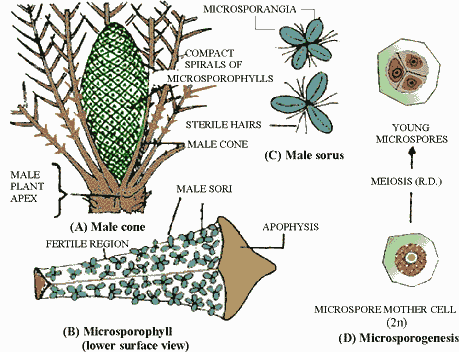|
PinkMonkey Online Study Guide-Biology

Click here to enlarge
Figure 15.10
Male cone (Fig. 15.10): The male cone (i.e. male
strobilus) is compact, large (up to 50 cms long) and oval. It is
produced singly at the apex of the male plant. Further growth of the stem
is sympodial and takes place by the activity of a lateral bud.
The male cone consists of a thick central axis on which numerous
microsporophylls are arranged in compact spirals. Each microsporophyll
is small and flat. It is differentiated into a lower narrow fertile
region and a terminal broad, sterile apophysis with a pointed
apex. The lower surface (abaxial surface) of the fertile region
bears numerous small microsporangia (pollen sacs). They
are organized into groups or sori. Each group has 3-6 microsporangia.
Each microsporangium contains many diploid microspore mother cells
(pollen mother cells). They divide by meiosis and produce
haploid microspores (pollen grains). These are liberated
from the cone and carried by wind during pollination (wind pollination).
|